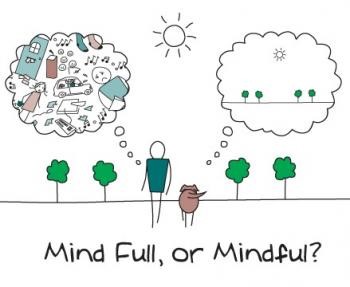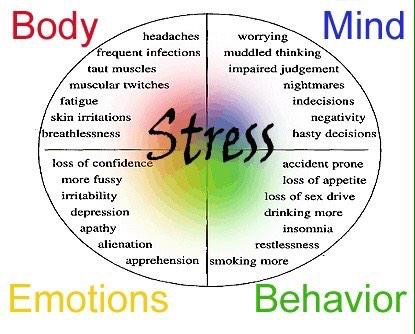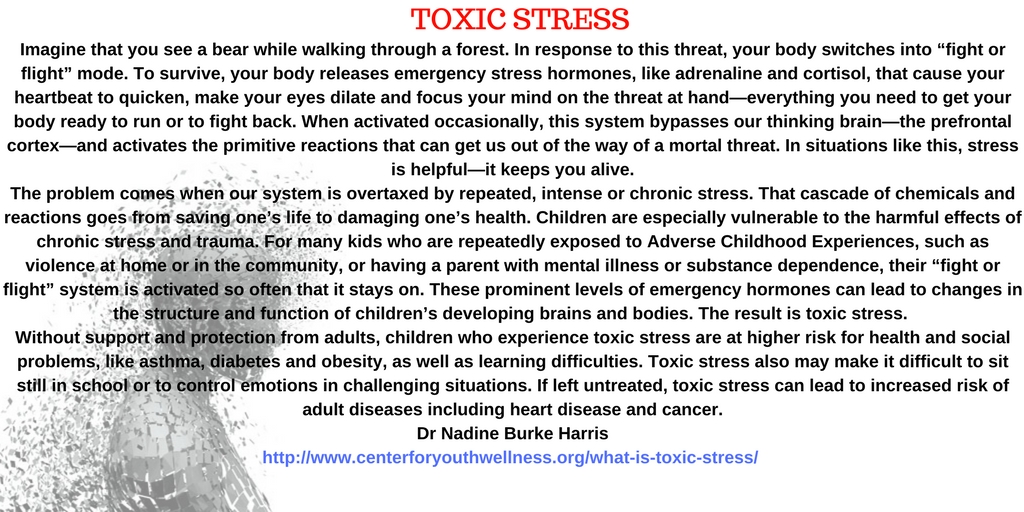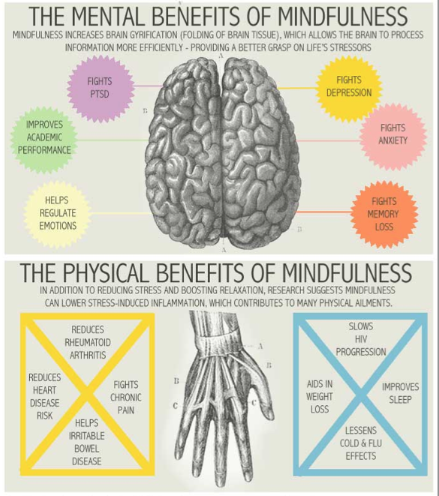[To save and read later, download here]
In this busy life, we often rush from one thing to another without stopping and appreciating the beauty around us. Commitments, pressures, and worries take over, and staying awake to our present experience become more and more difficult. Mindfulness meditation helps us to stop, breathe, and reconnect with our present experience.
Mindfulness meditation has become more widespread and popular than ever before. This fast-growing phenomenon is being endorsed by celebrities such as Emma Watson, Ruby Wax and Angelina Jolie. Why? Because research is showing time and time again, that if mindfulness is practiced daily for a minimum of 8 weeks, there are huge psychological and physical health benefits such as a reduction in stress and anxiety, and the prevention of depression (Krusche et al, 2013; Baer et al, 2012; Mark et al, 2014; Rycroft-Malone et al, 2014; Williams & Kuyken, 2012; Teasdale et al, 2000)
Where did Mindfulness come from?
In 1979 Jon Kabat-Zinn 1 developed an eight-week Mindfulness-Based Stress Reduction (MBSR) program to help people with pain management. This course harnessed the fundamentals of mindfulness meditation as taught by the Buddha, but with the Buddhism taken out. In 2002, a psychologist Professor Mark Williams 2 worked with colleagues to combine the US program with cognitive behavioural therapy (CBT) to form an eight-week mindfulness-based CBT course (MBCT). In 2004 this MBCT course was recommended for prescription on the NHS for recurring depression. Mindfulness practice is now approved by the National Institute of Clinical Excellence and is available on the NHS.
What is Mindfulness?
“Mindfulness means paying attention in a particular way; on purpose, in the present moment and non-judgementally.”
Jon Kabat-Zinn
Within mindfulness practice, we are encouraged to focus on the present moment in a deliberate and mindful way, to become more aware of arising thoughts, feelings and sensations in the body. Being aware of our present experience in a non-judgmental and compassionate way helps us to acknowledge and accept these thoughts, feelings, and sensations so that we can assess our response before reacting impulsively. Therefore, the practice of mindfulness teaches the mind a new way of relating to thoughts and feelings, so we can choose how to respond to circumstances rather than react.
Mindfulness is practiced by focusing on the body and breath and can also be practiced in everyday activities, like walking or eating. By focusing on the present experience of our body and breath, we teach ourselves to become aware of thoughts, feelings and bodily sensations, acknowledge them, and stay with them as they arise and pass.
Mind full or Mindful?

As adults we often have busy minds which tend to flitter from one thought to another- this is called the “butterfly brain” – our minds jump from one thought to another, making it difficult to maintain focus or concentration. We are normally too busy paying attention to our thoughts and engaging with them, that we neglect to pay attention to our present moment. While we are busy with our thoughts, we may also neglect to notice any arising emotions linked to these thoughts, or may even ignore how these thoughts and emotions may manifest in the body.
In this busy world we live in, we often forget about our bodies, how delicate and precious they are. Psychological and physical illness can sometimes creep up on us because we have learned to ignore our bodies, in favour of the mind. The body sends us signals or flickers, like gentle biological taps on the shoulder, letting us know that something is out of balance. Often in this frantic world, we tend to ignore these flickers or see them as inconvenient irritations hoping that they don’t detract us from the things we need to do. However, these physical signs and symptoms are our bodies way to alert us to deeper imbalances and can often be the manifestation of the thoughts and emotions we experience throughout the day.
Signs of Stress: emotions, behaviour, feelings, and thoughts
Stress is our bodies reaction to feeling under threat or attack. When we are stressed, panicked, or anxious, a part of the brain called the amygdala 3 is triggered – this is a primitive part of the brain which activates the flight, fight, freeze, flop or friend response. Frequent and recurring activation of this part of the brain floods our bodies with stress chemicals such as adrenaline and cortisol, leading to the symptoms in the diagram on the right.
Within the practice of mindfulness meditation, we can prevent stress, anxiety and long-term health issues, if we pay attention to how we hold emotions with the body by becoming more aware of the relationship between thoughts, feelings, emotions and the body. If we monitor our body and notice all its fluctuating propensities, then we can become connected from the body, and less entangled with our thoughts.
The Neuroscience of Mindfulness: what does the scientific research say?
MRI scans show that after an eight-week mindfulness course, the brain’s “flight or fight centre”, called the amygdala appears to shrink. As the amygdala shrinks, the pre-frontal cortex (associated with higher order brain functions such as awareness, concentration, and decision-making) becomes thicker.
The connection between these 2 regions of the brain also changes, so the connection between the amygdala and the rest of the brain gets weaker, while the connections between areas associated with attention and concentration get stronger. There is also an increased thickness of the hippocampus which governs learning and memory.
An area of the brain called the insula also thickens with mindfulness practice and becomes more strengthened. This part of the brain is integral to our sense of human connectedness as it helps to mediate empathy for ourselves and others.
How do these structural changes of the brain benefit us in our everyday lives?
The physical and psychological benefits of practicing mindfulness meditation are astounding. Mindfulness boosts the immune system, lowers blood pressure and reduces the risk of heart disease.
Not only does mindfulness reduce stress and anxiety, it increases focus, performance, and memory. There is an increased sense of calm, and a reduction in worrying, as we learn to stop ruminating about the past and future, and gain greater self-awareness. Empathy and understanding of others also increases, as we become more accepting of ourselves and others.
Going forward with Mindfulness practice
Mindfulness meditation is not an alternative to counselling or psychotherapy. It does not “solve” our difficulties but instead reveals an awareness of the underlying issues we may need to work on. It gives us the opportunity to choose how we respond to these underlying issues, and how we respond to the world.
Mindfulness meditation encourages us to connect to parts of ourselves which we may not like or find too painful to connect with. However, only through true connection with these challenging parts of ourselves can there be real development and growth as individuals
DAILY MINDFULNESS TIPS
- Start the day with mindfulness – attention to a few breaths before getting out of bed
- Notice your body while standing or walking
- Bring awareness to listening or talking
- Notice changes in your posture throughout the day
- Bring awareness to eating
- When you feel tired, frustrated, anxious, angry or any other powerful emotion, bring your attention to your breath
- Remember to breathe
- Maintain a daily mindfulness practice
- Before you go to sleep, bring an awareness to your breath
Other useful Blogs:
References
Baer, R.A., Carmody, J., Hunsinger, M. (2012) Weekly Change in Mindfulness and Perceived Stress in a Mindfulness-Based Stress Reduction Programme, Journal of Clinical Psychology, 68(7), 755-765.
Krusche, A., Cyhlarova E., Williams J.M.G. (2013) Mindfulness Online: An Evaluation of The Feasibility of a Web-Based Mindfulness Course For, Stress, Anxiety and Depression, British Medical Journal, October 2013(3), BMJ Open
Mark, J., et al (2014) Mindfulness-Based Cognitive Therapy for Preventing Relapse in Recurrent Depression: A Randomized Dismantling Trial, Journal of Consulting and Clinical Psychology
Rycroft-Malone, J., et al (2014) Accessibility and Implementation in UK Services of and Effective Depression Relapse Intervention Programme – Mindfulness-Based Cognitive Therapy (MBCT): ASPIRE Study Protocol, Implementation Science
Teasdale et al (2000) Prevention of Relapse/Recurrence in Major Depression by Mindfulness-Based Cognitive Therapy, Journal of Consulting and Clinical Psychology
Williams, M., Kuyken, W (2012) Mindfulness-Based Cognitive Therapy: A Promising New Approach to Preventing Depressive Relapse, The British Journal of Psychiatry
- A professor of Medicine at the Centre for Mindfulness in Medicine, Health Care, and Society at the University of Massachusetts Medical School
- The former director of the Oxford Mindfulness Centre
- The amygdala is a primal region of the brain, associated with fear and emotion and is involved in the start of the body’s response to stress.





